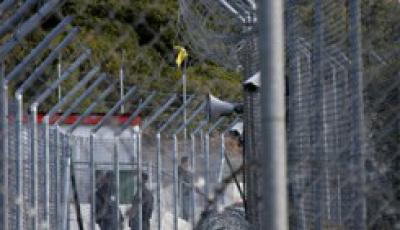Immigration Detention, Human Rights, and Language: New Research from the Global Detention Project
Posted
Time to read
Guest post by Michael Flynn, Founder and Project Manager of the Global Detention Project, Geneva. The Global Detention Project is an inter-disciplinary research initiative that investigates the role detention plays in states’ responses to global migration, with a special focus on the policies and physical infrastructures of detention. The project is based at the Graduate Institute’s Programme for the Study of Global Migration.

An increasing number of countries around the world are relying on immigration detention as an important tool for managing their populations of undocumented migrants and asylum seekers. This development has generated a growing backlash among rights actors, who are concerned about the negative impact detention can have on the physical and psychological wellbeing of migrants. Analysis of how states have responded to criticism of their detention practices raises a number of disquieting questions:
- Is there a relationship between states’ increasing reliance on immigration detention and their adoption of formal procedures and rights-based approaches to the deprivation of liberty?
- If states are intent on demonizing migrants and associating them with criminality—as many states appear to be—then why bother to disguise immigration detention practices behind anodyne terminology and remain tight-fisted with statistics on this practice?
- When immigration detention amounts to a punitive measure, which it often appears to be, should authorities provide the same procedural guarantees to these detainees that they provide criminal inmates?
These questions are at the heart of a series of new working papers recently published by the Global Detention Project (GDP), the content of which I summarise below.
In The Hidden Costs of Human Rights: The Case of Immigration Detention, I point to the puzzling fact that although most liberal democracies have sought to boost their detention and deportation capacities in recent years, they resist public scrutiny of these activities. What explains this simultaneous reticence towards and embrace of immigration detention?

One partial explanation could be the way states have responded to human rights advocacy on behalf of migrant detainees, absorbing norms related to the treatment of detainees while evading those that call into question states’ efforts to detain or deport non-citizens. A case in point is Europe: In contrast to other destination countries like the United States and Canada, most European countries ceased some time ago to use criminal facilities for the purposes of immigration detention, and the EU Returns Directive provides that member states should use specially planned facilities for confining people as they await deportation. This shift, from informal to formal detention regimes, has closely paralleled calls by rights actors, like the Council of Europe, to ensure that administrative detainees are not imprisoned alongside criminal inmates. Notably, with the advent of specialised detention facilities, states have massively boosted during the last two decades the numbers of people they detain.
What is the connection between these developments? Here the case of Ireland is illustrative. Ireland’s immigration detention estate has been notable for two main reasons—its exceedingly small number of detainees each year (numbering in the dozens) and the fact that it has no official facility to confine these people. However, in 2006, after an official visit to the country, the Council of Europe’s Committee for the Prevention of Torture (CPT) admonished Ireland for detaining failed asylum seekers slated for deportation in prisons. The CPT pointed out that this treatment violated norms established in the European Convention on Human Rights. The CPT then recommended that Ireland build a facility that would be dedicated to this purpose. In its response, the government of Ireland promised to do just that, stating that it was in “ongoing discussions with the Irish Prison Service… with the aim of providing a separate purpose built facility for immigration offenders at the new complex that conforms to best international standards.”
As the American investigative journalist Deepa Fernandes wrote in her book Targeted: Homeland Security and the Business of Immigration, “
Grange highlights GDP research revealing a clear trend in many countries to cast deprivation of liberty in a favourable—or, at the very least, less menacing—light. For instance, in Turkey immigration detention was for many years officially labelled “accommodation in guesthouses for foreigners” (the country recently adopted the term “removal centres”). In Ukraine, detention is described in the law on the Legal Status of Foreigners and Stateless Persons as “accommodation in the temporary stay facilities for foreigners and stateless persons who stay in Ukraine illegally.” Mexican law provides for the “hosting” of irregular migrants in “migratory stations” (migrantes alojados en estaciones migratorias). In Malaysia, immigration detention centres are called “depots.” New regulations in Spain seek to change the current name for detention centres, “foreigners internment centres” (centros de internamiento de extranjeros), to “centres for the controlled stay of foreigners” (centros de estancia controlada de extranjeros). And in Bulgaria, detention takes place in “specialized homes for temporary accommodation of foreigners,” which the law calls “coercive accommodation.” One observer in Bulgaria reported that this confusing terminology led a journalist from the Bulgarian state television to describe the detention centre as a “charity home.”

International and regional agencies also appear to be eager to disguise or otherwise shield immigration detention. A case in point is the burgeoning discussion of “migration management.” As one scholar cited by Grange has written, “most approaches to manage migration are out-sourced and entrusted to non-EU actors such as the IOM
All three of these recent GDP working papers point to a common theme: Although immigration-related detention has become a global phenomenon involving a range of state and non-state actors, its legal and normative boundaries remain deeply obscured. An important reason for this obscurity appears to be the distinct discomfort states often show when locking people up outside criminal processes, which has made immigration detention a much cheaper activity than it ought to be. Coming to terms with the real costs of detention will require not only increasing transparency of this practice, but also forcing states to provide the full range of guarantees that anyone deprived of his or her liberty must be granted.
Want to start a discussion about this topic? Post a comment here or on our Facebook page. You can also tweet us.
__________
How to cite this blog post (Harvard style):
Flynn M (2013) Immigration Detention, Human Rights, and Language: New Research from the Global Detention Project. Available at: http://bordercriminologies.law.ox.ac.uk/global-detention-project (Accessed [date]).
Share
YOU MAY ALSO BE INTERESTED IN
With the support of









